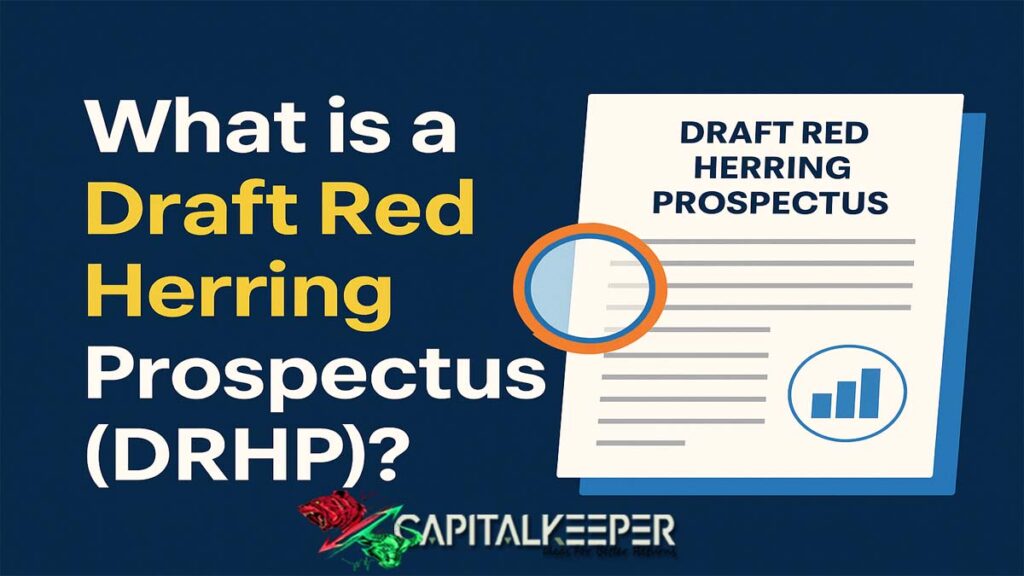What is a Draft Red Herring Prospectus (DRHP)? A Guide for IPO Investors
By CapitalKeeper | Beginner’s Guide | Indian Sock Market | Market Moves That Matter I 05th June 2025
What is a Draft Red Herring Prospectus (DRHP)? A Complete Guide for Investors
When a company plans to go public and raise funds through an Initial Public Offering (IPO), the first official document it submits to SEBI is the Draft Red Herring Prospectus, or DRHP.
Understanding this document is crucial for any retail or institutional investor who wants to make informed investment decisions during an IPO. Let’s break down what the DRHP is, why it matters, and how to read it like a pro.
🔍 Definition: What is a DRHP?
A Draft Red Herring Prospectus (DRHP) is a preliminary registration document filed by a company with SEBI before it launches an IPO. It outlines the company’s:
- Business model and operations
- Financials (profit/loss, assets, liabilities)
- Purpose of raising funds
- Risks involved
- Promoters and management details
- Legal matters and litigations
📌 The DRHP does not include the final issue price or number of shares those come later in the Red Herring Prospectus (RHP).
🧾 Why is the DRHP Important?
For investors, the DRHP is the foundation of IPO analysis. It helps you:
- Understand the company’s fundamentals
- Assess risks and opportunities
- Gauge management credibility
- Check use of IPO proceeds (growth or debt repayment?)
- Compare peers and market positioning
📂 Key Sections in a DRHP You Should Focus On
1. Risk Factors
This section lists all internal and external risks that may affect the company. Always read this thoroughly.
2. Use of IPO Proceeds
Will the money be used for debt reduction, expansion, R&D, or just working capital? This tells you the company’s growth intent.
3. Business Overview
Describes the company’s core operations, revenue streams, and industry trends.
4. Financial Statements
Look at revenue growth, profit margins, debt-to-equity ratio, and cash flow.
5. Peer Comparison
Compare the company’s valuations (P/E ratio, ROE, etc.) against its competitors.
6. Promoter Holding and Lock-in Period
High promoter holding is generally a positive sign. Check if they are exiting in the IPO.
How to Access a DRHP
You can easily read a company’s DRHP by visiting:
- SEBI’s official website
- Stock exchanges: BSE India or NSE India
- Lead manager or company websites
Search under “Public Issues” → “Draft Offer Documents”
Real-Life Example: DRHP of Tata Technologies
When Tata Technologies filed its DRHP in 2023:
- It highlighted its strong global engineering portfolio
- Stated intent to use funds for capex and R&D
- Revealed healthy EBITDA margins and low debt
- But also warned about dependency on global auto OEMs
Many investors analyzed this DRHP and positioned themselves before IPO pricing was announced.
📝 Final DRHP vs RHP: What’s the Difference?
| Aspect | DRHP | RHP |
|---|---|---|
| Status | Draft (preliminary) | Final (approved by SEBI) |
| Price Band | Not disclosed | Disclosed |
| Issue Size | Tentative | Finalized |
| Public Comments | Allowed (within 21 days) | No comments accepted |
| Legally Binding? | No | Yes |
📈 Analyst’s Take: Why You Should Read the DRHP Before Any IPO
As a financial analyst, I consider DRHPs a goldmine of information. If you ignore it, you’re investing blind.
By reviewing a company’s DRHP:
- You can avoid overhyped IPOs with weak fundamentals
- Spot hidden gems early
- Strategically allocate capital, even before anchor investors jump in
📌 Conclusion: DRHP is Your First Step to Smart IPO Investing
If you’re serious about IPOs not just chasing short-term listing gains then reading the DRHP is non-negotiable. It helps you invest with clarity, avoid risks, and even ask better questions in public forums or with brokers.
So, the next time you see IPO buzz on social media, head to SEBI and read the DRHP first.
📌 For daily trade setups, technical learning, and smart investing tips, stay tuned to CapitalKeeper.in
📌 For more real-time updates, trade setups, and investment insights — follow us on [Telegram] and subscribe to our newsletter!
📌 Disclaimer
The content provided on CapitalKeeper.in is for informational and educational purposes only and does not constitute investment, trading, or financial advice. While we strive to present accurate and up-to-date market data and analysis, we make no warranties or representations regarding the completeness, reliability, or accuracy of the information.
Stock market investments are subject to market risks, and readers/investors are advised to conduct their own due diligence or consult a SEBI-registered financial advisor before making any investment decisions. CapitalKeeper and its authors are not liable for any loss or damage, direct or indirect, arising from the use of this information.
All views and opinions expressed are personal and do not reflect the official policy or position of any agency or organization. Past performance is not indicative of future results.By using this website, you agree to the terms of this disclaimer.

